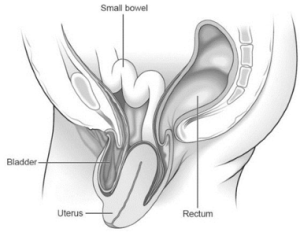I am sure that many of you are wondering what uterine prolapse is (like I was when I saw it in The Advocacy Project fellowship application). Here you will get a glimpse into what uterine prolapse is and how it impacts the lives of Nepali women.
Definition
The descent or herniation of the pelvic organ, uterus, rectum or bladder into the vagina (Amnesty International ,2014); when the muscles (levator ani muscles/ pelvic floor) around the uterus weaken the and the uterus moves into the vagina.
Uterine: relating to the uterus (the female organ that develops eggs) or womb (Merriam-Webster)
Prolapse: out of place (Merriam-Webster)
Is Uterine Prolapse Treatable?
Yes. There are 4 stages of uterine prolapse and different ways to treat each stage.
- Stage 1: uterus is in the upper half of the vagina; muscle strengthening exercise can prevent continued muscle weakness
- Stage 2: uterus is at the opening of the vagina; a ring pessary is placed into the vagina to keep the uterus in place and support pelvic organs
- Stage 3 & 4: uterus protrudes or is completely out of the vagina; pelvic floor repair surgery is done to tighten vagina walls or a hysterectomy is completed to remove the uterus.
Do women die from this?
NO! But it still affects women’s DALYs (Disability-Adjusted Life Year) and in Nepal many women are abused due to their condition. More on this can be read: Vulvodynia: Is a ‘Depressed’ Vagina The Reason You Find Sex Painful?
Common Causes
- Old age
- Young child bearing age
- Strain on pelvic muscles from obesity, heavy object lifting, constipation, or persistent coughing
- High number of births and low periods between
- Prolonged difficult labor
- Malnutrition
- Pushing down on abdomen during labor
*The causes in italics are common among Nepali Women*
Symptoms
- Uterus protruding from vagina (severe cases); sometimes ulcers on prolapsed uterus
- Backache
- Difficulty carrying out daily tasks, walking, sitting, lifting objects
- Difficulty urinating or defecating
- Urine leaking
- Sexual intercourse discomfort or difficulty
- Discharge and strong odder from vagina
Barriers
- Social Stigma/ Shame: Women avoid treatment because of fear that family and/or community members will hate and isolate them. Women have also experienced physical and emotional abuse.
- Cultural Practices: Men have the authority to decide if a woman can seek health care in certain caste groups and communities. Women are in charge of heavy manual labor to sustain household income. Women are deemed useless if they are not able to bare children and work.
- Lack of Health Care Access: Healthcare clinics are not available in every region of Nepal. For some the trip to a health clinic or hospital is too expensive. The trip and treatment would also require the women to take off work which reduces the household income.
What is being done in Nepal?
The Nepali government mainly focuses on treatment of uterine prolapse. One way they ensure treatment is provided is through prolapse screening camps where surgery is given to women diagnosed with uterine prolapse. Monitoring and prevention of uterine prolapse is lacking however. Only focusing on treatment for uterine prolapse will not stop women from developing uterine prolapse. Also ignoring the issues surrounding uterine prolapse such as gender discrimination is a violation of international law.
During my fellowship I will explore how Care Women Nepal (CWN) is effectively addressing the issue of uterine prolapse through helping facilitate the Women’s Health Camp.
Posted By Lindsey Killett
Posted Jun 21st, 2018




10 Comments
Samantha Givens
June 21, 2018
Thank you Lindsey for such an interesting and educating post. This information is new to me and I appreciate learning from you!
Lindsey Killett
June 25, 2018
Thanks for reading! Happy it helped!
Ali West
June 21, 2018
Lindsey, this blog was extremely helpful in understanding just what uterine prolapse is. I have a much better understanding of the issue now thanks to you!
Lindsey Killett
June 25, 2018
Happy it helped! 🙂
Corinne Cummings
June 21, 2018
Hey Lindsey. Today’s blog post was extremely educational, before reading your posting, I was completely unaware of what a uterine prolapse was and the repercussions it consequently brings upon women. I have a couple of questions that I would like to ask, what is the age that women become most commonly experience a uterine prolapse in Nepal and around how many women suffer from this each year there? I am interested in this topic after reading your posting. Thank you for thoroughly explaining and providing a diagram for your readers–it made your post even easier to understand. Keep up the excellent work you are doing in Nepal; I look forward to reading your future posts. Best wishes, Corinne.
Lindsey Killett
June 25, 2018
Thanks for you questions! From previous research the median age that women first experience uterine prolapse is 26 (that’s my age!). It is very hard to track exactly how many women in Nepal experience uterine prolapse but a study from 2012 estimated that approximately 600,000 Nepali women suffer from the condition! Happy all of this was easy to understand!
Nity Jaiswal
June 22, 2018
This is a very informational blog, Gives a very clear picture of the issue. keep up the good work.
Lindsey Killett
June 25, 2018
Thank you! Happy you enjoyed!
Princia Vas
June 29, 2018
Amazing blog and very informational! Thank you for creating awareness about Uterine Prolapse through your blog 🙂
iain
July 5, 2018
Very clear and compelling description of a horrible condition. Love the fact that you took the time to answer comments….